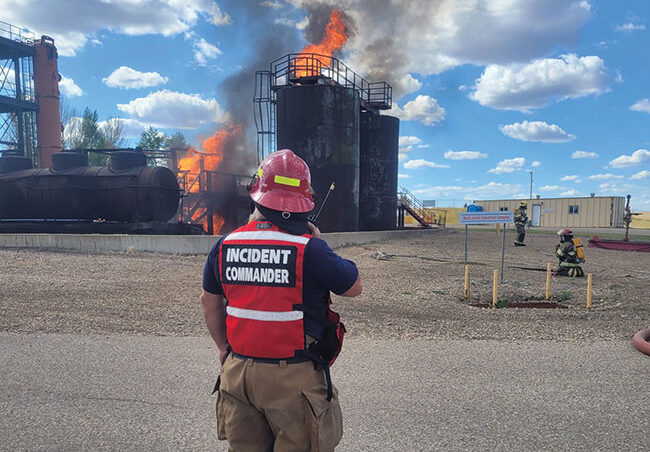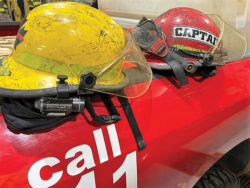
Features
Leadership
Wildfire Week
Leadership in the time of Climatistry
Change is all around, but the guiding principles of leadership remain the same.
October 30, 2023
By Kirk Hughes
 Whether in a position of management in the field, or in the administrative chair, a leader must always consider the welfare of the people they command, as well as the job that has to be done.
photos: Kirk Hughes
Whether in a position of management in the field, or in the administrative chair, a leader must always consider the welfare of the people they command, as well as the job that has to be done.
photos: Kirk Hughes Don’t bother Googling it, Climatistry (a mixture of the word climate and chemistry) isn’t a real word, but there is no word to describe the interesting time the fire service is quickly transitioning into, so I’ve given it this invented moniker.
Change is inevitable, and innovation and technology have vastly improved the fire fighting profession, yet this is a unique period contrasted against the backdrop of an altering climate, interconnected with technologically advanced communities, and the shifting constructs of the traditional environment of the fire station. One of the more prevalent challenges is the struggle to link previous tried and true leadership styles while appealing to the modern generation of firefighters’ needs, wants and expectations. The up-and-coming rank and file have differing expectations, and with that comes a host of new and unexpected obstacles. To overcome these hurdles, the goal of any leader is to adapt to the change, and the best way to do so is to embrace the core leadership traits and apply them with some humility and flexibility.
So, what are the core leadership traits? Sounds like a buzzword of sorts, and every department will have differing vision statements and nomenclature that try and capture the main points of what they want their leaders to exemplify. Generally, it emphasizes the position of responsibility and authority, but it still boils down to three main takeaways: being firm, friendly, and fair. These are the core competencies that make up the framework of an effective leader in the evolving fire service.
There are many goals for any leader to achieve, but one of the most critical is making followers resilient to the adverse effects of the job. Exposure to gruesome sights, sounds, smells, and dealing with chaotic and frightening scenes impacts the psyche of any first responder. Followers tend to do well in those circumstances when they know their leader will respond in a specific way. Knowing with relative certainty the consequences of your actions is a liberating concept for anyone, but in those high-pressure situations, understanding how a leader will react brings stability to an otherwise tense and emotionally charged scenario. Being firm doesn’t mean being inflexible, it just means that the leader’s actions and directions are often familiar, as predictable as possible, and ultimately, their decision-making process is as confident as allowable under the circumstances. This is a hard skill for young leaders to master, and it does take extensive exposure in order to fully appreciate the difficulty of this skillset, however it is a lasting one as a person grows into a more senior position. Being firm is a mindset, it includes giving orders based on the best available information, being flexible enough to alter that order if new information comes to light, but still maintaining an unwavering stance, especially in situations where difficult orders or decisions must be made and carried out. Sometimes, as a leader, hard calls must be made, it’s the price of wearing the shoulder braids, but if your followers know that you are working in their best interest, for the greater good and favourable outcomes, they tend to be more understanding and willing to accept that decision than they would be if they didn’t have the solid belief in the principles and firmness in resolve of their senior leadership.
That may all sound a tad harsh, being firm in and of itself is usually seen as being of strict resolve, however if properly mixed with a strong sense of belonging, born out of such things as camaraderie, then it tends to take the edge off. For the sake of fluency, this stage is often referred to as friendly, in the sense that it encompasses the key components of most emergency services personnel: dedication, self-discipline, compassion, etc. As a leader, those traits must be more present and upfront to alleviate the heavy hand that often comes with command. Subordinates react more effectively to a leader that they have positive feelings towards, generally appreciate and fundamentally respect. Being friendly doesn’t equate to being weak; the argument is the opposite. A strong leader that is firm in their deportment yet still approachable with a positive attitude, often has a successful crew. The rationale is extensive, but it generally boils down to empowered employees that are trusted, respected, and cared for, tend to be more loyal, willing to take on more complex assignments and want to perform at a high-level to maintain the relationship they are experiencing.
So, how does a leader build that rapport with their subordinates, especially those in the new up and coming generation? A solid question, with ample answers, but sticking to the theme of core competencies, the main thrust is always to treat them with dignity and respect, empower them, invest in them and, simply, push them to succeed, not only for themselves, but for the overall health of the organization as a whole. A subordinate that feels that their leadership is professional yet approachable, will be a valued member of a team and a pleasure to lead.

More than just a colour on a helmet or a title, being a leader means making a call, often in rapid time.
A firm resolve and a friendly demeanour are keen aspects of a good leader, but the last piece of the pie has to be fairness. People will take a lot of grief in their job, their hobbies, or their social lives, but rarely will they take it if they do not think what is occurring is fair. It’s a balancing act to be fair while maintaining a position of authority. Merging competing interests is never an easy task, but a common one amongst leaders. Being fair comprises facets of honour, neutrality, equality and more importantly, being reasonable. The main teaching point when explaining fairness is to remove self-interest and replace it with an over arching desire to be unbiased. Easier said than done truthfully, as unconscious biases invade many aspects of life in general, however being mindful of those preconceived notions is always the best first step when debating if a decision is based in the merits of fairness. Being equitable, yet maintaining a logical principle based in established processes helps. For example, if a decision must be made in relation to a promotion, then making a selection based on a criteria which includes a coherent set of explainable benchmarks such as training or seniority, then the results are not based on individual preferences but rather can be viewed as legitimate in their conclusion. That way the decision can be seen as transparent, consistent and, critically, in its totality – fair.
At times difficult decisions will result in some getting angry, feeling their needs weren’t met and the impact on them exclusively was unfair. That is bound to happen in any organization that has hierarchy, such as a fire service, and is disheartening to leaders that struggled with reaching the end result while trying to evenly apply the aspects of fairness to the decision. In those circumstances, the only real recourse is to communicate the process to everyone involved and try to answer questions and concerns with the core tenets of firmness, friendlessness, and fairness. Even then, sometimes no answer will satisfy, and the last recourse is just to accept it, deal with the fall out, and move on.
As the field of fire fighting evolves and grows, so too must the leaders that wish to command firefighters. Since leadership itself has hundreds of different styles, techniques, methods, and approaches, it is foolhardy to think they can all be boiled down to three simple phrases. Leadership, like fire fighting, requires experience, education and mentorship. Finding a style is paramount, but like all professionals maneuvering through the maze of challenges and changes that will serve to improve the fire service, maintaining the roots of the core competencies cannot lead you astray.
Kirk Hughes is the Director of Protective Services and Fire Chief for the County of Vermilion River in Alberta. Kirk previously served in the Royal Canadian Mounted Police as well as several fire services across Ontario, Manitoba, the Northwest Territories and Southern Alberta. His Facebook page can be found at Protective Services – County of Vermilion River.
Print this page